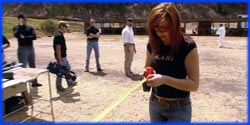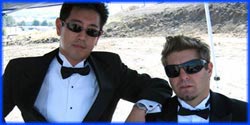


Premier Date: January 4, 2010
busted
Adam and Jamie set up three steel plates at 90-degree angles, along with a .45 caliber pistol and a cardboard cutout of Jamie behind it. In three trials with different types of ammunition (unjacketed lead, full metal jacket, and total metal jacket) all of the bullets fragmented after striking the first plate. A fourth trial, using a hardened steel ball bearing in a bullet casing, led to three ricochets and a hit on the shooter; however, the projectile struck at a less-than-lethal speed.
Other materials were then investigated for use as ricochet surfaces, starting with measurements of ricochet angles and speeds from only one plate. Cinder block pavers were chosen over lead due to the latter’s tendency to make bullets tumble and lose too much speed. When Adam and Jamie set up three pavers and fired a total metal jecket round, they observed three ricochets and a less-than-lethal hit on the Jamie cutout.
Finally, the MythBusters bent a piece of metal plumbing pipe into a curve to serve as a bullet guide, firing into one end toward a block of ballistic gelatin at the other end. A 46-inch (117 cm) diameter curve, forming nearly a full circle, resulted in lethal speed and penetration on the target. Adam and Jamie declared the myth busted, owing to the slow speed of the bullet after three ricochets.
busted
The Build Team began by visiting a tree plantation to determine the amount of bending force a typical conifer could withstand without breaking. Their first test, on a Gray Pine, gave a result of 2,000 pounds (907 kg); they loaded Buster into a second such tree and applied the same force, but he only fell to the ground when they released it.
Returning to the workshop, they set up some small-scale tests with saplings of three different types – Douglas-fir, redwood, and Alaskan cedar – and a miniature Buster figure. Preliminary trials showed that the fir could give the longest range for the same bending angle, so the team trimmed off the limbs and attached a tether to keep the payload in place until the right moment. With these modifications, the sapling flung the dummy all the way to the other end of the shop.
At the plantation, the team found a full-size Douglas-fir and set it up in the same way, aiming at a bouncy castle 100 feet (30 m) away with a 40-foot (12 m) balloon “wall”. With 2,400 pounds (1,089 kg) of bending force on the trunk, Buster flew almost all the way to the castle, but hit the ground just short of it. Because they were unable to hit their target even with the benefit of modern machinery and cutting off all the limbs, the team declared the myth busted.
Previous: Episode 136: Mini Myth Mayhem